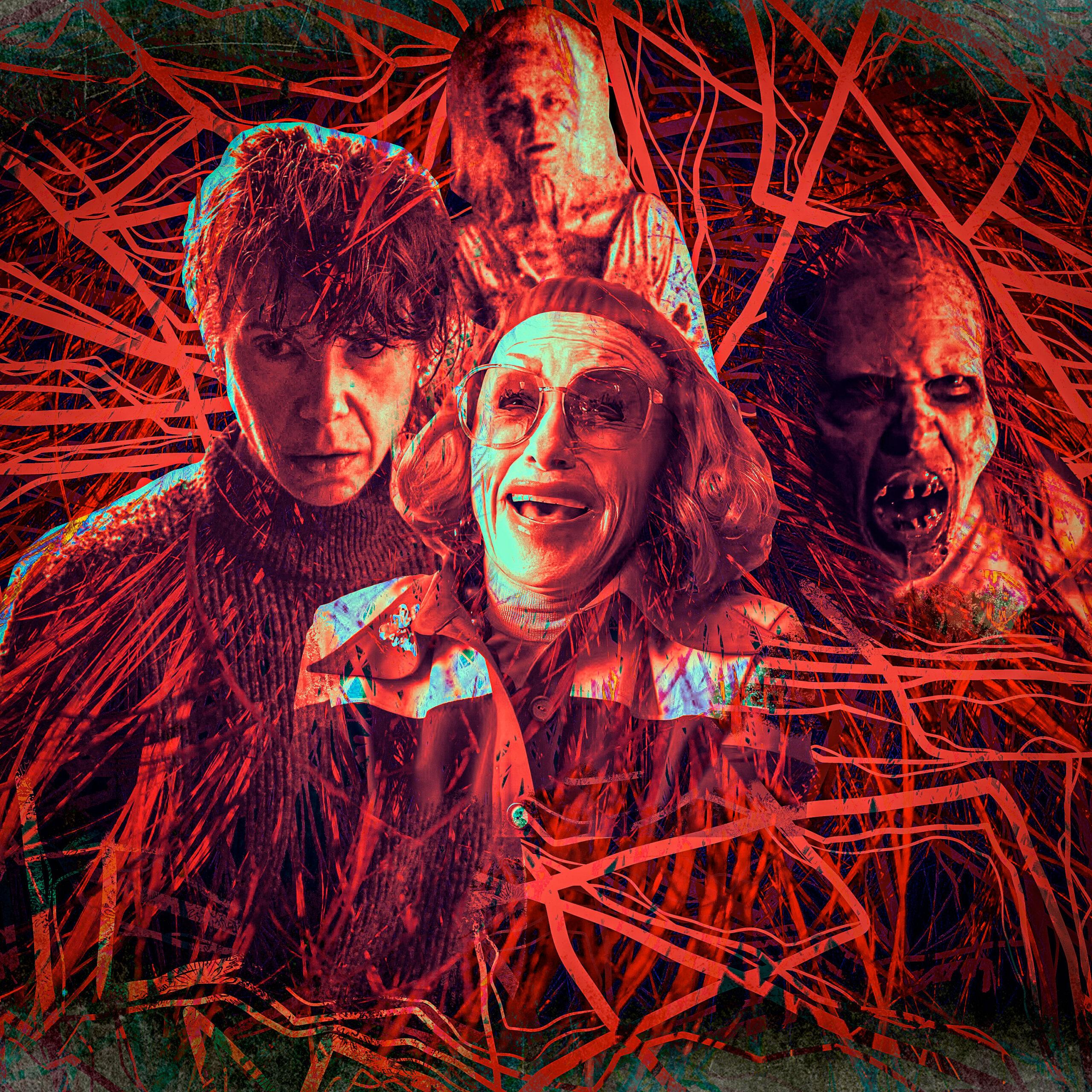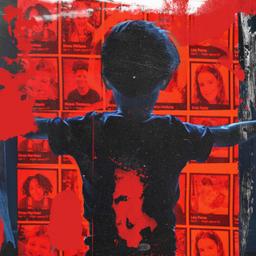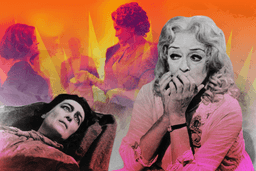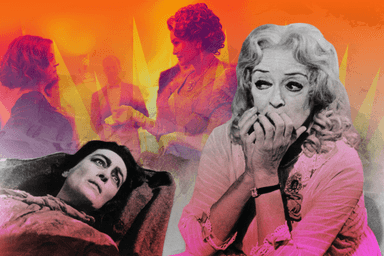
Get out your Ouija boards and chunky foundation, because hags are back! In case you don’t know what I’m talking about: the decrepit, woo-woo ladies that serve as the explanation for all the spooky stuff happening in a horror movie. Think What Ever Happened to Baby Jane?, Sunset Boulevard, and The Visit. But we’ve also been seeing plenty of this trope lately. From X to The Substance to Barbarian to Bring Her Back, creepy old women are out in full force to haunt your dreams.
But what makes a hag a hag? Let’s briefly go over the rules.
- An elderly, haggard appearance: This is obvious—the trope plays on our fear of aging, and especially of women aging. Prosthetic makeup is often employed to exaggerate the effects of aging, and that’s usually paired with some cakey foundation and splotchy lipstick to imply our hag’s attempt to cover up her, um, imperfections.
- Some sort of glamorous or successful background: Norma Desmond was a silent film star. Baby Jane was a child vaudeville performer. Elisabeth Sparkle helmed a popular aerobics show. The background of a horror hag can range from something specific, like a once thriving entertainment career, to something broad, like youthful beauty or motherhood. Either way, her attempt to reclaim her lost past beyond what can be achieved with a retinol serum is what motivates her reign of terror.
- A detachment from reality: Going hand in hand with rule no. 2, hagsploitation’s villains are suffering from severe delusions that cause them to believe they can age backward or revive the past. Barbarian’s basement monster thinks she can breastfeed her way into capturing a motherhood she never got to experience. Baby Jane thinks singing a song about writing a letter to her daddy will be just as endearing in her 50s as it was when she was 9. Bring Her Back’s Laura thinks she can get away with kidnapping and murder and resuscitate her dead daughter. These women believe that through sheer force, they can will their lives to become what they once were, or what they never were, and no one will question it.
The latest crack at hagsploitation comes in Zach Cregger’s new horror phenomenon Weapons, the no. 1 movie in America for two weeks in a row. Amy Madigan plays—spoiler for anyone interested in hagsploitation who hasn’t seen the film yet—sweet, old Gladys, a sickly aunt with a botched blunt bang who dabbles in witchcraft. Her motivation for possessing 17 children and making them Naruto run out of their Craftsmans into the dead of night isn’t totally spelled out, but it’s implied that she’s somehow sucking the lifeblood out of them to cure an unnamed illness. Plus, considering her attempts to mask her appearance under a tacky wig and gaudy makeup and the fact that she targeted kids, it’s not far-fetched to assume that she was after some type of youthful reinvigoration.
Unsurprisingly, the hagsploitation genre—also called “psycho-biddy” films in the past—has been subject to criticism since its inception. In a 1962 pan of What Ever Happened to Baby Jane?, Los Angeles Times film critic Philip K. Scheuer wrote that the picture “mocks not only its characters, but also the sensibilities of its audience.” Bette Davis’s similarly themed follow-up, Hush … Hush, Sweet Charlotte, was described as “grisly, pretentious, disgusting, and profoundly annoying” in a New York Times review. Nowadays, the misogynistic implications of the trope are often reckoned with. In playing on societal fears of aging women, is hagsploitation satirizing or reinforcing them? Do these films punish or mock their villains for their vanity? Are the reasons this vanity exists interrogated?
Given all these exhaustively noted problems, why is hagsploitation having a moment? While the genre has always been a precarious balancing act between regressive stereotypes and subtly feminist explorations of what can drive a woman mad, the recent hagsploitation films have either been totally up-front about addressing the trope’s problems on-screen or opted to avoid them completely. This wave of films has also moved away from schlocky horror and toward an elevated feel—prestige distributors like A24 and Mubi have been behind a few recent hag hits—and the genre has even been represented at the Oscars. Still, that hasn’t made these movies immune to criticism—even films that have been showered with praise or have raked at the box office tend to perpetuate the very stereotypes they might be seeking to subvert. Polarized reactions are essential to the hagsploitation tradition, and modern takes are no exception.
The recent trend kicked off with Ti West’s 2022 slasher, X, in which Mia Goth plays both Maxine, a 20-something aspiring adult film actress, and Pearl, the sexually repressed elder who allows Maxine and Co. to shoot a pornographic movie on the farm she owns with her husband. As X unfolds, we learn that Pearl struggles to have sex with her husband due to his heart condition and is envious of the sexual freedom she observes as Maxine films her scenes. Naturally, this leads to a killing spree! X certainly found an audience—it received positive reviews and made $15 million worldwide against a small indie budget—but it was quickly overshadowed by its prequel. Pearl explored the backstory of its villain—placing her younger self in, you guessed it, the entertainment industry—and provided some insight into her interiority beyond “horny grandma.” While Pearl slightly underperformed its predecessor at the box office, Goth’s portrayal of its protagonist made the character a franchise icon and led the movie to thrive in film circles online. In using a second movie to explore its hag’s motivations, the X series underlined a recurring issue in the genre: Its villains’ characterizations are often shallow.
Cregger’s Barbarian attempted to right this by emphasizing the male violence that led its hag to her current state. The film’s big bad—a disfigured shut-in caught somewhere between human and creature credited only as “the Mother”—is downright sympathetic when placed in the cycle of rape and incest that led to her creation. Barbarian was sure to hammer home that the Mother was just a product of her environment—placing the blame squarely on her abuser for unleashing unspeakable evil onto the world.
What rang hollow, though, was the Mother’s desire to be a mother. It’s common for horror hags to be desperate to cling to some sliver of femininity from their youth, but in Barbarian’s case, the Mother was robbed of any semblance of a life, let alone femininity. Her grasp at maternity came off like a shallow portrayal of what a woman stripped of everything would long for. Plus, a majority of the scares came from the notion that a woman so horrifyingly grotesque could be delusional enough to make that grasp in the first place—undermining the attempt to center male violence as the culprit of Barbarian’s horrors. This year’s Bring Her Back, the second effort by the Philippou brothers, directors of Talk to Me, also dealt with a longing for motherhood. While that movie does involve a witchy woman attempting to relive the past (in this case, by trying to bring her daughter back from the dead via a demonic ritual), Bring Her Back sidesteps many of the hagsploitation pitfalls by not concerning itself with appearance at all. Sally Hawkins’s Laura isn’t haggard or disfigured, and the movie instead focuses on maternal grief.
Another key entry in the hagsploitation revival was Coralie Fargeat’s The Substance, marketed as a truly feminist attempt at the genre. Demi Moore’s Elisabeth is an over-the-hill TV aerobics star (from back before there were fitstagrammers) who gets canned by her network after her 50th birthday. (Moore was actually 61 when The Substance came out—perhaps having her play her actual age was a bridge too far?) She turns to a black market drug, which—via some gnarly practical effects—causes the 20-something Sue (Margaret Qualley) to unzip out of Elisabeth’s body, with her consciousness to boot. Through Sue, Elisabeth gets to rewind the clock and extend her glory days, but misuse of the drug causes Elisabeth’s original body to age beyond recognition, and she grows resentful of her younger form.
Fargeat has said that she wrote The Substance as an explicitly feminist text: “I wanted to do it on purpose, to really address what I was feeling in terms of inequality,” she told IndieWire in 2024. This approach was showered with accolades—The Substance won Best Screenplay at its Cannes premiere before Moore went on a tear through awards season. She ultimately fell short of the Best Actress Oscar, but the film still nabbed five nominations (including Best Picture) and one win (for Best Makeup and Hairstyling) at the ceremony—which is basically unheard of for nasty body horror fare.
For all its intentions and the praise it received, The Substance still didn’t completely avoid the drawbacks of hagsploitation. While Moore’s motivations for chasing a youthful appearance are made clear by her network’s treatment of her (though Dennis Quaid’s Harvey, a smarmy producer, is sidelined for much of the film as the focus shifts to the struggle between Elisabeth and Sue), the shadowy entity behind the Substance drug—which is blatantly profiting off of Elisabeth’s insecurities—is hardly shown at all. Shouldn’t whatever system produced this drug—much like those who hawk antiaging snake oil in real life—shoulder some responsibility for marketing itself on oppressive beauty standards? As the film moves away from interrogating the forces around her, and Elisabeth’s misuse of the drug proves to be the source of her worsening appearance, the film opts to mock Elisabeth rather than sympathize with her.
Which brings us to a total 180 in Weapons and Aunt Gladys. With largely positive reviews from critics and a second weekend at no. 1 at the box office, the film is clearly connecting with audiences. But how does it handle hagsploitation? It mostly buries the genre’s major themes. First of all, it was not marketed as hagsploitation—Gladys was hardly featured in any trailers, and the movie instead built its buzz off of its suburban nightmare premise. Compare that to 2024’s Longlegs, which certainly could fall under the hagsploitation category, albeit with a male hag in Nicolas Cage’s titular serial killer. That movie also built its hype off a marketing campaign that promised big scares—but in that case, the hype was centered on Cage’s villain specifically. (A few days before Longlegs came out, Neon released a clip of lead actress Maika Monroe seeing Cage in costume for the first time, complete with a heart rate monitor.) When the movie revealed that Longlegs was pretty comparable to any number of horror hags, and a thinly written depiction of one at that, audiences were largely underwhelmed (as evidenced by a Cinemascore of C+). I would argue that Gladys as a character is just as underwritten and stereotypical as Longlegs, but because Weapons never promised a particular big bad, she reads as the kind of left turn that Cregger’s building a career out of rather than a disappointment. But underneath it all, the flaws are still there: scares derived simply from an older woman’s appearance and a surface-level interrogation of her motivations.
So is it possible to truly remake hagsploitation in a feminist image? Despite efforts to address the trope’s issues head-on or avoid them completely, using an aging woman in cheap lipstick as a jump scare feels, well, cheap. The best horror doesn’t just tap into our fears but forces us to confront them. I’m not above gasping at a blunt bang, but what about Gladys’s appearance scares us so much that just a flash of her face makes us jump out of our seats? Maybe the genre just isn’t equipped to answer that, or maybe it still needs another makeover.







